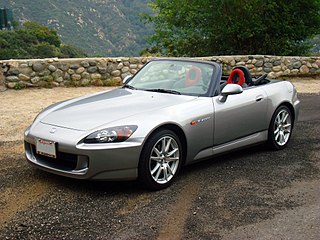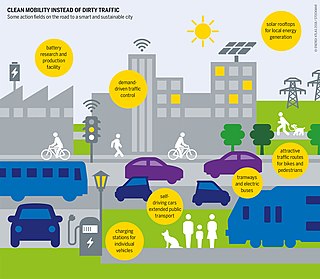
A flying car or roadable aircraft is a type of vehicle which can function both as a road vehicle and as an aircraft. As used here, this includes vehicles which drive as motorcycles when on the road. The term "flying car" is also sometimes used to include hovercars and/or VTOL personal air vehicles. Many prototypes have been built since the early 20th century, using a variety of flight technologies. Most have been designed to take off and land conventionally using a runway. Although VTOL projects are increasing, none has yet been built in more than a handful of numbers.

In transportation, platooning or flocking is a method for driving a group of vehicles together. It is meant to increase the capacity of roads via an automated highway system.

Electronic stability control (ESC), also referred to as electronic stability program (ESP) or dynamic stability control (DSC), is a computerized technology that improves a vehicle's stability by detecting and reducing loss of traction (skidding). When ESC detects loss of steering control, it automatically applies the brakes to help steer the vehicle where the driver intends to go. Braking is automatically applied to wheels individually, such as the outer front wheel to counter oversteer, or the inner rear wheel to counter understeer. Some ESC systems also reduce engine power until control is regained. ESC does not improve a vehicle's cornering performance; instead, it helps reduce the chance of the driver losing control of the vehicle.

The Honda Insight is a hybrid electric vehicle that is manufactured and marketed by Honda. Its first generation was a two-door, two passenger liftback (1999–2006) and in its second generation was a four-door, five passenger liftback (2009–2014). In its third generation, it became a four-door sedan (2018–2022). It was Honda's first model with Integrated Motor Assist system and the most fuel efficient gasoline-powered car available in the U.S. without plug-in capability — for the length of its production run.

The Honda S2000 is a front-mid engine open top sports car that was manufactured by Japanese automobile manufacturer Honda, from 1999 until 2009. First shown as a concept car called the SSM at the Tokyo Motor Show in 1995, the production version was launched on April 15, 1999, to celebrate the company's 50th anniversary. The S2000 is named for its engine displacement of two litres, while "S" stood for "sports" carrying on in the tradition of the S500, S600, and S800 roadsters of the 1960s.

Sustainable transport refers to ways of transportation that are sustainable in terms of their social and environmental impacts. Components for evaluating sustainability include the particular vehicles used for road, water or air transport; the source of energy; and the infrastructure used to accommodate the transport. Transport operations and logistics as well as transit-oriented development are also involved in evaluation. Transportation sustainability is largely being measured by transportation system effectiveness and efficiency as well as the environmental and climate impacts of the system. Transport systems have significant impacts on the environment, accounting for between 20% and 25% of world energy consumption and carbon dioxide emissions. The majority of the emissions, almost 97%, came from direct burning of fossil fuels. In 2019, about 95% of the fuel came from fossil sources. The main source of greenhouse gas emissions in the European Union is transportation. In 2019 it contributes to about 31% of global emissions and 24% of emissions in the EU. In addition, up to the COVID-19 pandemic, emissions have only increased in this one sector. Greenhouse gas emissions from transport are increasing at a faster rate than any other energy using sector. Road transport is also a major contributor to local air pollution and smog.

A plug-in hybrid electric vehicle (PHEV) is a hybrid electric vehicle whose battery pack can be recharged by plugging a charging cable into an external electric power source, in addition to internally by its on-board internal combustion engine-powered generator. Most PHEVs are passenger cars, but there are also PHEV versions of sports cars, commercial vehicles and vans, utility trucks, buses, trains, motorcycles, mopeds, and even military vehicles.

A hover car is a personal vehicle that flies at a constant altitude of up to a few meters (yards) above the ground and used for personal transportation in the same way a modern automobile is employed. The concept usually appears in science fiction.
IEEE 802.11p is an approved amendment to the IEEE 802.11 standard to add wireless access in vehicular environments (WAVE), a vehicular communication system. It defines enhancements to 802.11 required to support intelligent transportation systems (ITS) applications. This includes data exchange between high-speed vehicles and between the vehicles and the roadside infrastructure, so called vehicle-to-everything (V2X) communication, in the licensed ITS band of 5.9 GHz (5.85–5.925 GHz). IEEE 1609 is a higher layer standard based on the IEEE 802.11p. It is also the basis of a European standard for vehicular communication known as ETSI ITS-G5.
Mild hybrids are generally cars with an internal combustion engine (ICE) equipped with an electric combined motor/generator in a parallel hybrid configuration allowing the engine to be turned off whenever the car is coasting, braking, or stopped, and then quickly restarted once power is again required. Mild hybrids may employ regenerative braking and some level of power assist to the internal combustion engine, but mild hybrids do not have an electric-only mode of propulsion.

The Lexus LF line is a series of concept cars built by Lexus, the luxury vehicle division of Toyota Motor Corporation. The "LF" designation refers to Lexus Future. The LF Series vehicles features coupes/convertibles, including: the LF-A, the LF-A Roadster, LF-LC, LF-CC, and the LF-C; sedans: the LF-S, LF-Sh, and LF-Gh; crossover SUVs: the LF-X and LF-Xh; and hatchbacks: the LF-Ch. The first concept vehicle of the LF Series, the LF-X, appeared in 2003. The LF Series utilizes L-finesse, a design philosophy named for "Leading Edge" and "finesse", which debuted on the LF Series concepts and later extended to all new production Lexus vehicles. New vehicle technologies on the LF Series include advanced instrumentation, multiple driver-selected vehicle configurations, hybrid and experimental powertrains, and unconventional driver interface designs. The vehicles also feature new design cues which derive from the L-finesse design language of "Intriguing Elegance" (純), "Incisive Simplicity" (妙), and "Seamless Anticipation" (予). Several of the LF concept vehicles have appeared close to their production counterparts, while the design cues of other LF concepts appeared on more distinctly different production vehicles.
Hybrid vehicle drivetrains transmit power to the driving wheels for hybrid vehicles. A hybrid vehicle has multiple forms of motive power.

The drag coefficient is a common measure in automotive design as it pertains to aerodynamics. Drag is a force that acts parallel to and in the same direction as the airflow. The drag coefficient of an automobile measures the way the automobile passes through the surrounding air. When automobile companies design a new vehicle they take into consideration the automobile drag coefficient in addition to the other performance characteristics. Aerodynamic drag increases with the square of speed; therefore it becomes critically important at higher speeds. Reducing the drag coefficient in an automobile improves the performance of the vehicle as it pertains to speed and fuel efficiency. There are many different ways to reduce the drag of a vehicle. A common way to measure the drag of the vehicle is through the drag area.

Subaru is the automobile manufacturing division of Japanese transportation conglomerate Subaru Corporation, the twenty-first largest automaker by production worldwide in 2017.

The CityCar or MIT CityCar is an urban all-electric concept car designed at the Massachusetts Institute of Technology Media Lab. The project was conceived by William J. Mitchell and his Smart Cities Research Group. It is now led by Kent Larson, Director of the Changing Places Research Group at the Media Lab. The project came into reality in 2003 under the support of General Motors. Time magazine choose the CityCar to be one of the "Best Inventions of 2007".

The Aerial Reconfigurable Embedded System (ARES) was a concept for an unmanned VTOL flight module that can transport various payloads. The concept started as the TX (Transformer) in 2009 for a terrain-independent transportation system centered on a ground vehicle that could be configured into a VTOL air vehicle and carry four troops. ARES' primary function was the same as TX, to use flight to avoid ground-based transportation threats like ambushes and IEDs for units that don't have helicopters for those missions. It was to be powered by twin tilting ducted fans and have its own power system, fuel, digital flight controls, and remote command-and-control interfaces. The flight module would have different detachable mission modules for specific purposes including cargo delivery, CASEVAC, and ISR. Up to 3,000 lb (1,400 kg) of payload would be carried by a module.

The Renault Twizy is a two-seat electric microcar designed and marketed by Renault. It is classified in Europe as either a light or heavy quadricycle depending on the output power, which is either 4 kW (5.4 hp) for the 45 model or 13 kW (17 hp) for the 80 model, both names reflecting its top speed in km/h. Originally manufactured in Valladolid, Spain, production was moved to Busan in South Korea in March 2019 to meet increased demand in Asia.

Experiments have been conducted on self-driving cars since 1939; promising trials took place in the 1950s and work has proceeded since then. The first self-sufficient and truly autonomous cars appeared in the 1980s, with Carnegie Mellon University's Navlab and ALV projects in 1984 and Mercedes-Benz and Bundeswehr University Munich's Eureka Prometheus Project in 1987. Since then, numerous major companies and research organizations have developed working autonomous vehicles including Mercedes-Benz, General Motors, Continental Automotive Systems, Autoliv Inc., Bosch, Nissan, Toyota, Audi, Volvo, Vislab from University of Parma, Oxford University and Google. In July 2013, Vislab demonstrated BRAiVE, a vehicle that moved autonomously on a mixed traffic route open to public traffic.
Krossblade Aerospace Systems is an aviation company founded in 2014 in Phoenix, Arizona, USA. The company is known for developing a 5-seat VTOL concept, SkyCruiser, hybrid vehicle for vertical take-off and landing, and for its drone/UAV prototype, named SkyProwler. Both aircraft employ the switchblade transformation mechanism to transform from a multirotor aircraft for vertical take-off and landing, to a pure winged aircraft, for rapid and efficient cruise.
Skyblazer or Sky Blazer may refer to:















